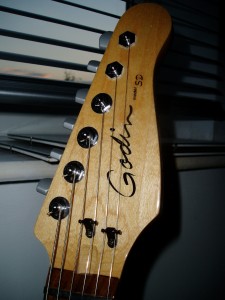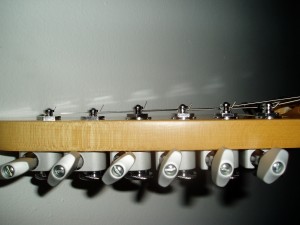Some might think that all these mods I make to my Godin SD mean I don’t like the guitar – no way! It’s because I like it so much that I can be bothered to spend a bit of time making it the best it can be…
As always, you may want to check out what Wikipedia has to say about guitar tremolos…
It wasn’t until recently that I started using the tremolo unit on my Strat quite a bit. Now it’s got to the point that I feel uncomfortable playing a guitar that doesn’t have a trem! Obviously my enhanced Godin isn’t complete without one…
Back when I first got the Godin, I messed around with its vintage-style tremolo a little bit and tried to get it working so that the guitar stayed in tune after a bit of trem action. I had a tech fit a graphite nut but still the damn thing wouldn’t stay in tune for long. Now I have my American Deluxe Strat, I’ve got a much better idea of what makes a tremolo stay in tune – locking tuners!
It’s a pretty well known fact that the method you use to string a guitar has a big effect on tuning stability. There are any number of crazy ways to tie strings on at the head of the guitar but the easiest and quickest way to get it right every time is to cheat. Locking tuners (a.k.a. locking machine heads) contain a small screw to clamp the string into the tuning post and eliminate the multiple wraps around the post that traditional methods generally use. It’s stretch and movement in these extra turns that is one of the major causes of guitars rapidly losing their tuning after a bit of whammy-abuse.

Install locking tuners! – string changes suddenly take just a few minutes and the improvement in tuning stability is nothing short of amazing.
The locking tuners installed on the Godin SD, clearly showing the thumb-wheel on each tuner used to tighten up the clamping screw. These are Sperzel satin-chrome locking tuners.
Installing the Sperzel tuners wasn’t without a minor complication…
The tuners have staggered heights to supposedly eliminate the need for string trees. Nice idea, but Sperzel (and, I imagine, other manufacturers?) have assumed you’re fitting them to a Fender guitar. The Godin has a slightly thicker headstock than the two Strats I have (15mm as opposed to 13mm) and, because of this, the tuning posts sit a little lower on the Godin than they would on a Strat. This meant I didn’t have enough room to fit the washer beneath the securing nut on the top two tuners!
 The front of the headstock showing the missing washers and the graphite nut. I’m not sure how much the graphite nut helps the tuning stability, my American Deluxe Strat does really well with its factory-standard nut (made of Tusq?). Certainly the graphite nut didn’t really help my earlier efforts at getting the trem working – so, if you’re going to spend, spend your money on locking tuners first.
The front of the headstock showing the missing washers and the graphite nut. I’m not sure how much the graphite nut helps the tuning stability, my American Deluxe Strat does really well with its factory-standard nut (made of Tusq?). Certainly the graphite nut didn’t really help my earlier efforts at getting the trem working – so, if you’re going to spend, spend your money on locking tuners first.
 Down at the other end, I removed one of the trem springs (from 3 to 2) and screwed the claw in quite tight to the body. I use 11 gauge strings on the Godin but it has a fairly short scale-length (24.75″ as opposed to a Strat’s 25.5″) so the string tension doesn’t feel much more than 10’s on a Strat. I don’t know whether the tension on these standard Godin springs is the same as Fender silver springs so this doesn’t make for a good comparison with a Strat. Anyway, this is what it took to set this particular unit floating.
Down at the other end, I removed one of the trem springs (from 3 to 2) and screwed the claw in quite tight to the body. I use 11 gauge strings on the Godin but it has a fairly short scale-length (24.75″ as opposed to a Strat’s 25.5″) so the string tension doesn’t feel much more than 10’s on a Strat. I don’t know whether the tension on these standard Godin springs is the same as Fender silver springs so this doesn’t make for a good comparison with a Strat. Anyway, this is what it took to set this particular unit floating.
 I read somewhere that, when setting a vintage-style tremolo to float, you should raise the four centre screws and have it pivot off the two outside screws like the 2-point floating tremelo that is now on Fender American series guitars. I’m not convinced about that (why would Leo Fender have put six screws there for no purpose?) but it’s difficult to get all those screws down to exactly the same level so I decided to go with that approach.
I read somewhere that, when setting a vintage-style tremolo to float, you should raise the four centre screws and have it pivot off the two outside screws like the 2-point floating tremelo that is now on Fender American series guitars. I’m not convinced about that (why would Leo Fender have put six screws there for no purpose?) but it’s difficult to get all those screws down to exactly the same level so I decided to go with that approach.
Pivoting off six screws rather than two is going to spread the load better and probably provide better coupling between the tremelo and the body resulting, I guess, in better tone/ more sustain… OK, I think I’ve just talked myself into screwing those back down…!
 Here’s the end result – the tremolo now floats 2/32″ off the body and actually stays in tune. I could probably raise it a little bit (3/32″ is apparently standard for vintage-style trems) which would give it more range but this works just fine.
Here’s the end result – the tremolo now floats 2/32″ off the body and actually stays in tune. I could probably raise it a little bit (3/32″ is apparently standard for vintage-style trems) which would give it more range but this works just fine.
Hmmm, nice view of that blue flame finish too… 


Hello, I have a Freeway myself. Also has a 6-point trem. There are some great videos on youtube showing how to float a tremolo and stay in tune (especially by this guy Frudua). One misapprehension people have is that the bridge pivots on the screws. I though so too until recently. Actually, there is a bevel on the bottom of the plate, and that is the pivoting point. The screws (all of them) just keep the bridge in place. So, to get the best performance, you have to raise all the screws so they don’t touch the plate. Try it and tell me what you think 😉
Thanks Davorin, that makes sense – I’ll give setting it up a go next time the strings are off 🙂
Another thing since you’ll have the trem off – look at the machining of said bevel on the front on the baseplate. Sometimes it’s rough or sloppily done. This surface is what moves against the body, so it makes sense (to me) that it should be smooth as glass.
If yours needs dressing, lay some fine sandpaper on a table and with the trem plate upright (remove the block) draw it towards you while gradually raising the back edge of the plate to accommodate the curve and get it nice and “slickery”.
Also it’s a misconception that raising the four center screws makes it pivot on only the outer screws. Think about it. Why would the height of a screwmake it lose contact with the hole? If the screw is there, its contacting the front edge of the hole! Lol
Removing a couple screws helps though. I just don’t think it helps “that” much, so I use all 6 for the best coupling.
Cheers! Bob
Hi, I have Godin SD as well and I’m planning on setup it’s tremolo)
Do you know any locking tuners that will fit better for it?
What kind of a tremolo arm should I order? (I bought a used item and it’s without one)
Thank you)
Hi Anton. Sorry I don’t know of any better tuners. These Sperzels work well, it’s just that more height would fit better. Armed with this knowledge (that the Godin’s headstock is slightly thicker than a standard Strat) you may be able to find something better. Not sure about tremolo arms either, my Godin’s one is stock. The one on my Strat was too tight a fit and my local guitar shop tech was able to make me a new one to fit it for very little money as part of a setup so maybe see if you can find a local tech to help you out. Good luck! 🙂
You can still get Sperzels just make sure you get the ones that don’t have staggered posts.
They have the non staggered option available.
Nicely done
I have a Freeway Classic that’s the same color as the SD here. I just took it to the shop to have the tremolo floated, and to add Schaller locking tuners. I also swapped out all the pick-ups, with a Lace Holy Grail replacing the single coil, a Seymour Duncan Pearly Gates at the neck and a Seymour Duncan TB-14 at the bridge…